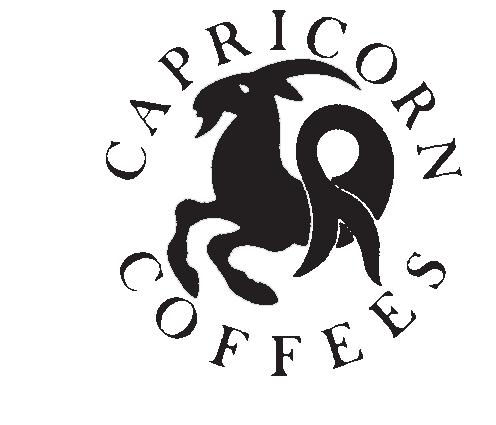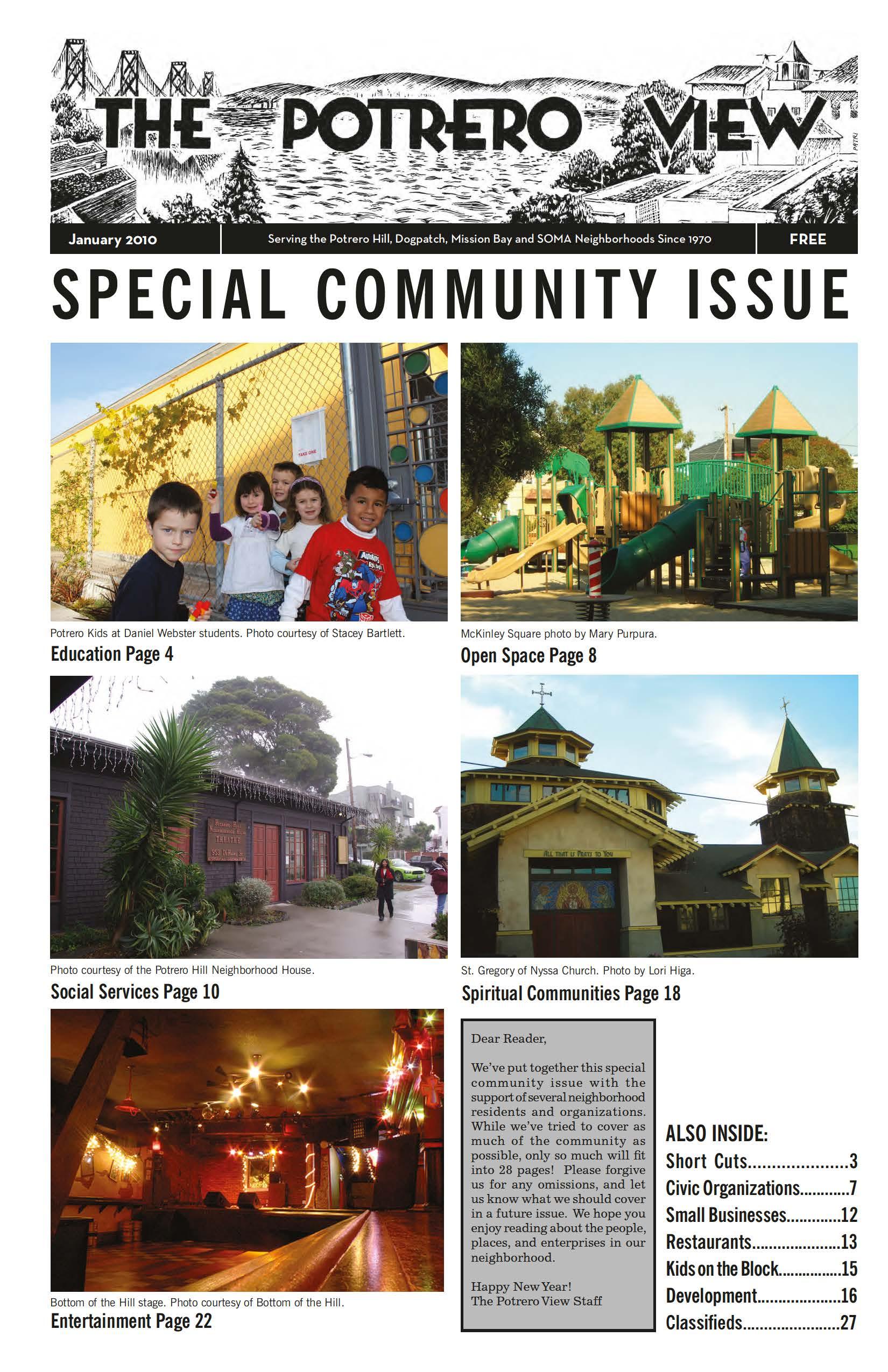
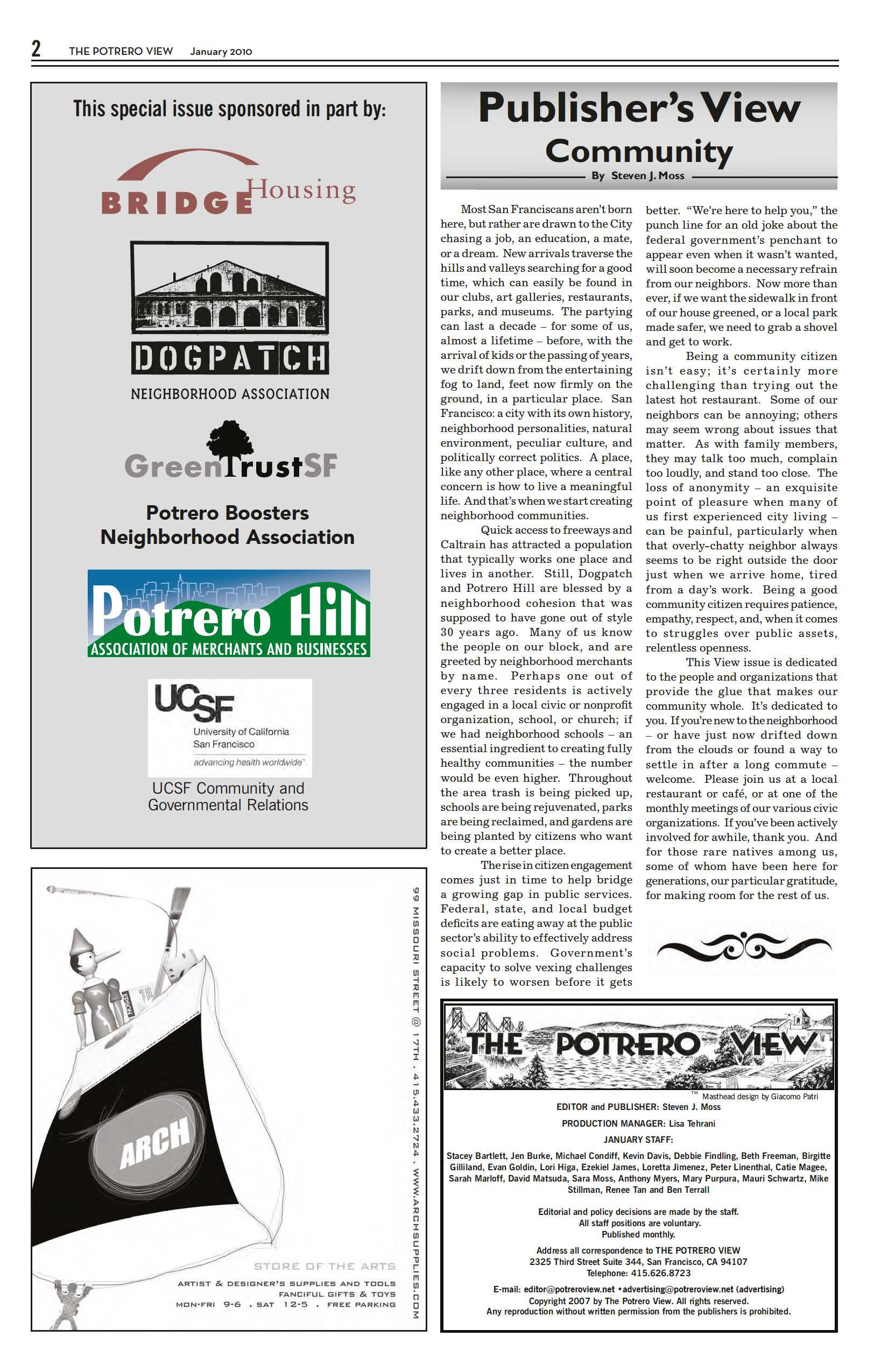
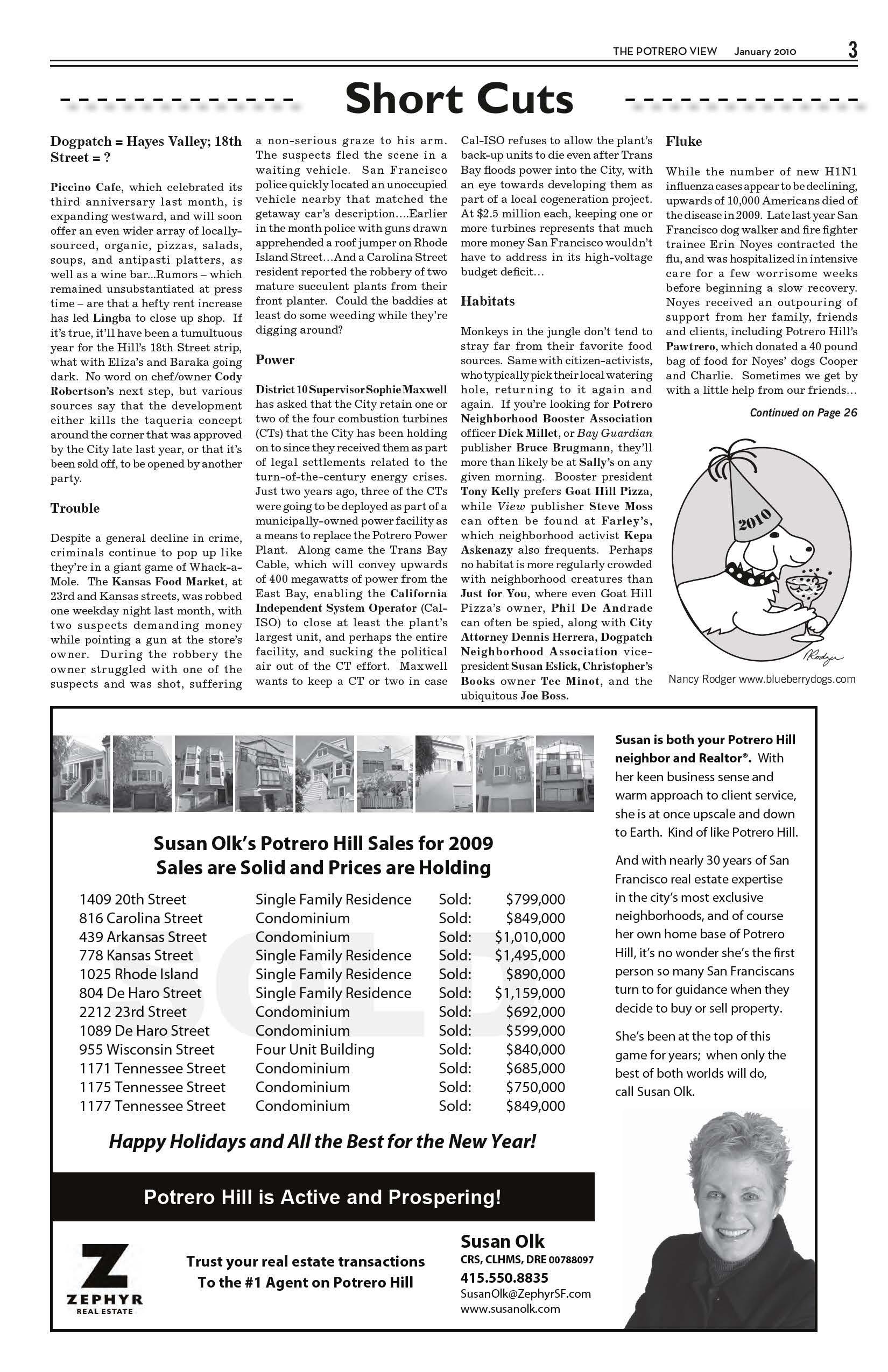
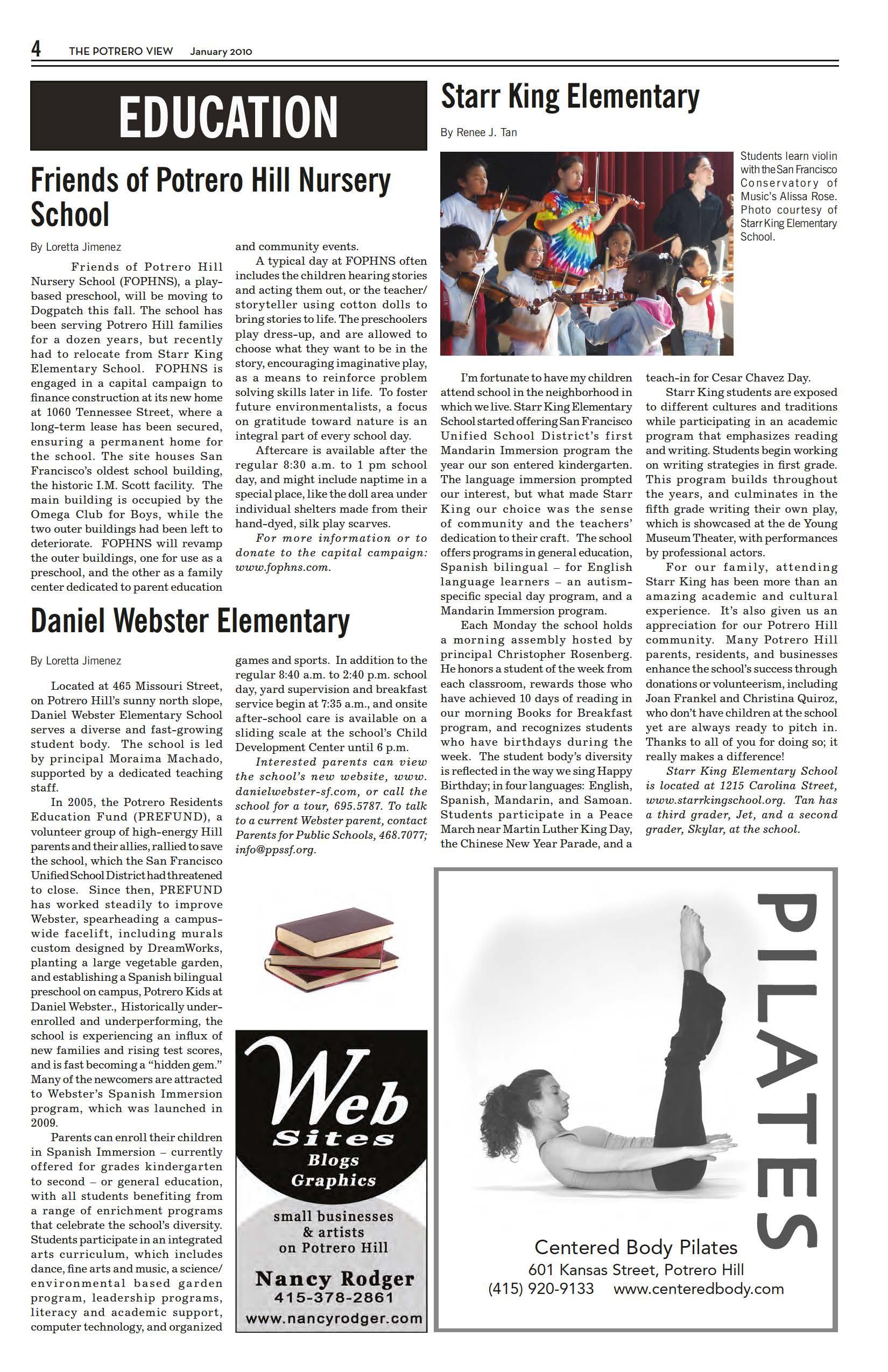
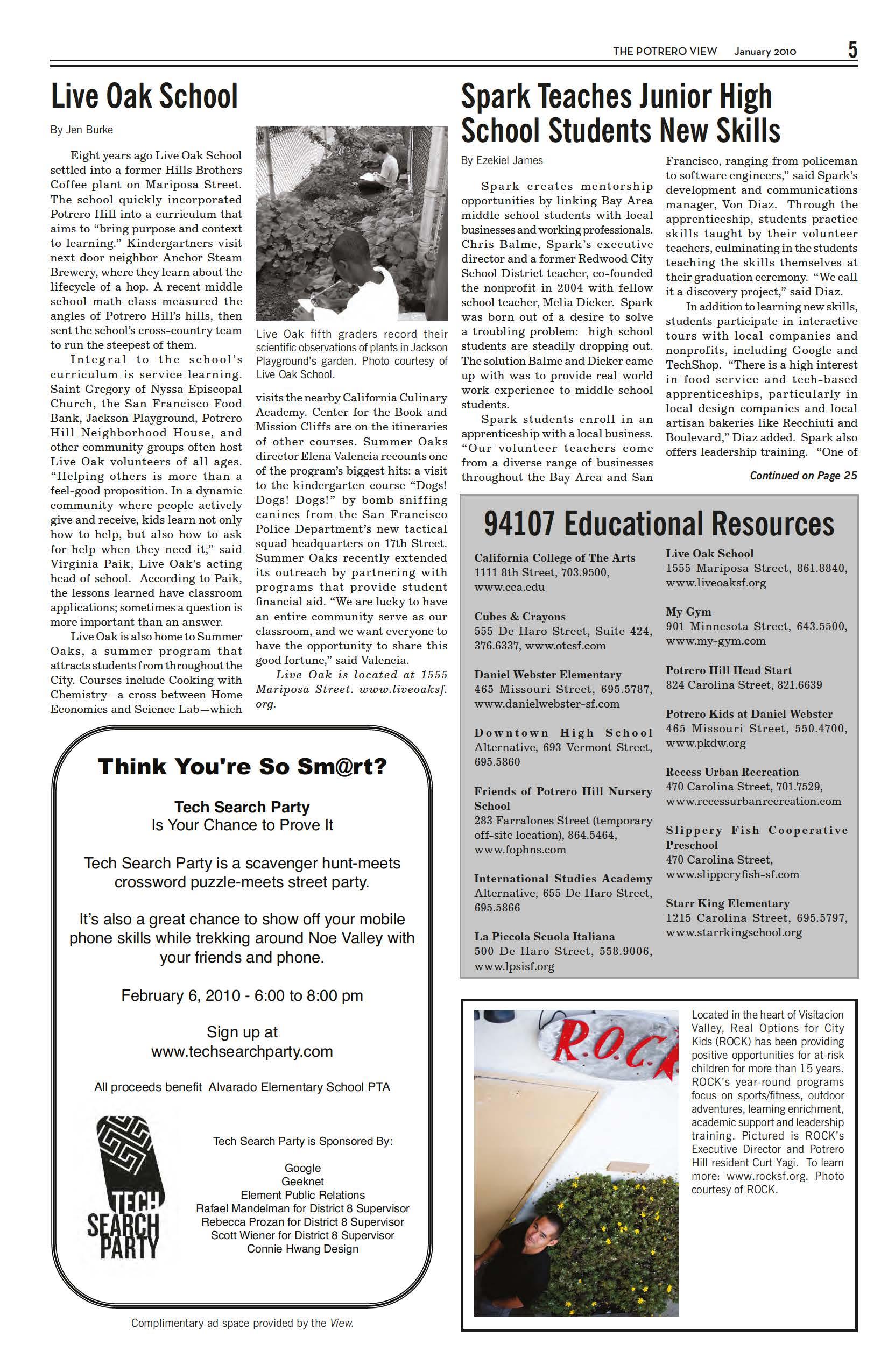






Potrero Hill Parents Association (PHPA) is a listserv for Hill parents interested in building a supportive parent community, and a great neighborhood for families. The listserv was launched in 2005, and has grown to 543 members.
The listserv emerged from a collaboration between the wellestablished, but dwindling in size, PHPA and a group of new parents who’d started to create sociallysupportive gatherings on the Hill. Natalie Freeburg, organizer of the new parents group, began the yahoo group that eventually merged with and rejuvenated PHPA. Freeburg served as moderator until 2008, while continuing to organize playgroups and community events.
In 2007, PHPA members engaged in heated online debates over listserv management, which resulted in a lull in membership and activity. Today the online community shares parenting and travel tips, free and for-sale clothes and children’s items, nanny and child care availability, play dates, job openings, and familyoriented neighborhood gossip. In 2008 Freeburg and her family temporarily moved to Texas. Sara O’Neill, a Hill parent and founder of Slippery Fish Cooperative, took over as the listserv’s moderator.
Science in the Teaching of Reading from Wheelock College, and a Bachelor of Arts in Developmental Psychology and Education from Briarcliff College. She devoted her life to helping children learn, grow, and ful ll their potential. A former teacher and lower school head at The Town School in New York City, Horton moved to the Bay Area in 1989 to help lead the Marin Country Day School in Corte Madera as the Assistant Head for Academic Affairs, where she worked for 13 years.
Holly Horton, the beloved Head of Live Oak School, passed away at her home on December 7, 2009, having fought a courageous battle against cancer. Horton, born in 1951 in The Borough of Queens, New York, eldest daughter of John J. Horton and Violet Walker Horton, is survived by her sister, Carole Parsons, Carole’s husband Bruce, their sons Ryan and Drew, her stepchildren Clayton Mannix and Meleah Mannix, Meleah’s husband Ethan Wimert, and their new daughter Dahlia, her devoted life-long friend, Brian Davis, and aunts, cousins, and many friends.

October - December 2008
3 home sales, 167 average days on market
$800,000 median sales price
October - December 2009
12 home sales, 48 average days on market
$992,500 median sales price
Let’s talk about how to get the most money for your home! I am taking reservations now for early spring listings.CallmetodayforaFREEMarketAnalysis.
In 2002 Horton was appointed to head Live Oak School, and proceeded to lead the institution toward a full realization of its mission and vision. She dedicated countless hours to the school’s success. She leaves an educational institution known for the care it provides to its students as well as the love seen amongst its community members. In addition to her headship, Horton served on the boards of the Bay Area Teacher Development Collaborative, the Marin Primary and Middle School in Larkspur, and Project Discover, a nonpro t collaboration with the San Francisco Boys and Girls Clubs designed to provide enrichment and support to children at risk.

Horton’s life embodied the words of the Live Oak School song, “From an acorn seed to a Live Oak tree, we harvest what we sow.” The many seeds of friendship and love she planted throughout her life culminated in
integrity, care and joy. Her home reflected a refined beauty and an eclectic hand-crafted sensibility that resonated with love, comfort and a warm welcome. An avid gardener, Horton created a piece of paradise in her Potrero Hill home and garden that sparkled with her energy. Horton tended her garden as she tended the lives of the children, faculty and staff at Live Oak School, as well as the individuals in her life, paying careful attention to each person and offering love and a nurturing ear. She had a passion for games of all sorts, cooking and entertaining, and her robust connection to a joyful life ltered into everything she did.
Donations in Horton’s honor may be made to The Holly Horton Scholarship Endowment Fund, Live Oak School, 1555 Mariposa Street, San Francisco, CA 94107.


Southeast San Francisco doesn’t have a vast open space like Golden Gate Park, or a well-funded gated community, such as the Presidio. But it does feature a large number of small, well-loved, ecologically diverse parks and green spots, and one good-sized urban park, 170-acre Candlestick Point State Recreation Area. Potrero Hill boasts four community gardens, a skate park, and the only privately-owned, hilltop open space in San Francisco. The Central Waterfront has several parks. Playgrounds are dispersed throughout the area.
The cherished parks and open spaces serve many different constituencies, including dog owners, families with young children, adults in search of fresh air and exercise, and teens and young adults seeking places to congregate. The needs of these constituencies are not always congruent. The green nooks and crannies that provide a respite from the urban, built environment often bear the marks of overuse and the pressures of the surrounding cityscape. Three out of four of the neighborhood’s community gardens are locked to guard against vandalism. A homeless encampment abuts McKinley Park. There’s the occasional smell of urine, or garbage. Some parks seem like a city planner’s afterthought, squeezed onto marginal bits of land. With large redevelopment projects planned for Showplace Square, Potrero Hill, South of Market, Bayview-Hunters Point, and Mission Bay, the steady in ux of more people and cars will further tax the area’s limited open space.
For most of its history Potrero Hill had an open feel, even though it didn’t have giant sprawling parks. Older-timers remember the red farmhouse at the intersection of De Haro and 19th streets, which was surrounded by an unusually large lot. Just seeing it when passing by walking, biking, or driving provided a sense of space. Developers built out every square inch of the lot, filling it with multiple units. The resulting effect is a crammed, closed feeling. This wall-to-wall build-out has been repeated throughout the neighborhood. The hill to the south of 26th Street, open and undeveloped until the end of the 1990s, was habitat to the endangered San Francisco garter snake. Now, individual houses and garages cover the hillside. Some south side residents who track these sorts of things haven’t seen a San Francisco garter snake in years.
But Potrero Hill residents are a resourceful and proactive lot. Over the years neighbors have re-greened the Hill. Annie Shaw’s efforts at the Pennsylvania Garden emanate
pure positive energy, transforming a forsaken corner of land into a blooming oasis, inspiring others to join in. The 18th and Rhode Island Permaculture Garden offers a cutting edge look at what local, urban food production in small spaces might look like.
The work continues. Recent proposed development at 1321 De Haro Street – which would quadruple the size of an existing building, shading and re-defining parts of the open space – threatens Starr King Openspace’s character. A potential helipad at San Francisco General Hospital could disrupt the tranquility of the skies above the neighborhood. As with efforts small and large throughout Southeast San Francisco, community members are
the garden produced roughly 1,000 pounds of fresh food, which was donated to the Free Farm Stand in the Mission District, which in turn distributes free organic food to those who can’t afford it. Permaculture Garden project coordinator David Cody estimated yields will triple this year.
The lot’s original soil wasn’t especially fertile. It consisted of a thin, sandy layer resting on the serpentine rock that de nes Potrero Hill. Cody and the other volunteers layered wood mulch donated by Bay View Greenwaste over cardboard donated from Whole Foods. Last year, the Eastern Neighborhoods Public Benefit Fund awarded the project $14,000. The funds will be used to develop seating and educational signs, and will help pay for research into identifying the best food plants for San Francisco’s unique climate.
To learn more or to find out about regular Friday workdays: www.18thandrhodeisland.org/ home.html.
Perched at the top of 20th and San Bruno streets, McKinley Square Park boasts some of the Hill’s best views. The park includes a playground, grassy patch, mulched walking paths, and off-leash dog area. It’s located next to one of San Francisco’s most established community gardens.
Two neighborhood groups, formed in the last year, are dedicated to the park’s evolution: the McKinley Square Community Association (MSCA) and the McKinley Square Park Foundation (MSPF). Both organizations are involved in a longrange planning process to develop and improve the open space.
Working together, both groups have raised $2,000 from the Innovator Awards, which is administered by San Francisco Parks Trust, a
38-year-old nonprofit. The funds will be dedicated to two projects: a community toolbox in the children’s play area that will house tools to remove graffiti, pick up debris from the sand, and facilitate cleaning and maintainance; and a foxtail eradication project – designed by Hill resident Tom Strother, who acts as MSCA’s treasurer – to research foxtail elimination, and implement the findings. Foxtails are fuzzy, wheat-like grasses whose seeds can painfully lodge in an animal’s paws, nose, and ears.
The foundation has received funds from the Eastern Neighborhoods Bene ts Trust Fund, which it plans to dedicate to developing landscaping plans for an enlarged park.
MSCA’s next meeting is Wednesday, January 13th from 6:30 to 8 p.m. at Downtown High School. Visit www.mckinleysquare.com for more information.
Mission Bay Families, a group of parents living and/or working in Mission Bay, are organizing to build a playground in the area, sooner rather than later. The Mission Bay building strategy includes plans for a playground, but the play space won’t be built until the surrounding lots are developed, which probably won’t happen for years. Mission Bay Families believes that the community would benefit from having a play area now.
According to the group’s website, more than 350 children live in Mission Bay, with less than half the planned housing built. The group has identi ed a small parcel next to the Pavilion Building on Channel Street where they’d like to develop a Tot Lot.
For more information, to join the organization’s google group, or to sign their petition: http://
responding to create the future our children will want to live in.

Permaculture principles emerged from experiences in rural areas. The permaculture garden at 18th and Rhode Island streets re ects an effort to put those ideas into practice in an urban setting. Permaculture is a design system that uses observation of natural systems as a model for creating sustainable environments.
Former Potrero Hill resident Aaron Roland, M.D. owns the double lot where the permaculture garden has taken root. Roland offered use of the lot to San Francisco Permaculture Guild members, who were trying to find urban spaces on which to grow food. Since the garden’s first workday in 2008, a lush polyculture – including yellow squash, lettuce, cabbage, red clover, and swiss chard interspersed with fruit trees – has blossomed in the sunny corner lot. In
missionbayfamilies.org/Home_Page. html.
Facing peak oil in earthquake country creates an appreciation for locally-sourced food. And food doesn’t get more local than what’s home grown. Community gardens enable city dwellers to grow their own, just like their country cousins. Potrero Hill has four community gardens: the Potrero Hill Community Garden at 20th Street and San Bruno Avenue; the Connecticut Friendship Garden on Connecticut Street south of 20th; the Potrero del Sol Garden at Cesar Chavez and Potrero Avenue; and the 25th and De Haro Street Green Spot, the newcomer in the bunch, having been established in the 1990s.
All the gardens have waiting lists for those who’d like to tend a plot. To get on a list, contact the coordinator at the garden that interests you: Potrero Hill Community Garden, info@potrerogarden.org, 449.0410; Connecticut Friendship Garden, Johanna.Gendelman@yahoo.com, 285.9736; Potrero del Sol Garden, pudup@ucsc.edu, 641.8988; and 25th and De Haro Green Spot, two4bike@ comcast.net.
Potrero Hill Garden Club usually meets the last Sunday of the month at 11 a.m. for a potluck lunch in a local home or garden. Call 648.1926 for details.
Esprit Park, a two-acre green space bordered by Minnesota, Indiana, 19th, and 20th streets, was willed into existence by the community. Established in 1982 by the clothing manufacturer Esprit Company, the park’s fate was unclear when Esprit moved out of the area. Friends of Esprit Park, a neighborhood group, worked hard to fundraise and preserve the open space. In 2001 the City took it over.
Esprit offers a fitness course – including bars and rings – with stations around the park; a running/ walking track; picnic tables; benches; and an open lawn for running around, lying in the sun, or walking on-leash dogs. Mature redwood trees frame the park on one side.
GreenTrustSF-CentralWaterfront
GreenTrust (GT) is dedicated to establishing and securing funding for a community-wide plan to create and improve open spaces for the Central Waterfront and Dogpatch, and to landscape additional areas in the community. The group has sponsored clean-ups and plantings at Warm Water Cove Park and Agua Vista Park, and has plans for larger open space projects.
GreenTrust’s most immediate goal is to complete a master plan for the greening of 22nd Street between Third and Pennsylvania streets. A community meeting was held last year to brainstorm ideas for the project, which resulted in a number of suggestions, including renovating
the 22nd Street Muni mini-park; adding sidewalk bulbs – planted areas bumping out into paved streets –adding landscaping and more street trees along 22nd Street, and improving the area around the 22nd Street rail stop.
One of GreenTrust’s main objectives is to develop a comprehensive plan for the area, rather than focusing on single site improvements. GT is working to adopt a green blueprint that identifies the geographic scope of the group’s work, ranks potential projects in order of community priority, identi es potential funding sources for targeted projects, and takes specific steps to implement the GreenTrust vision. GT hopes to leverage the City’s recently approved new development open space fee with additional local developer donations, grants and individual donations.
GreenTrust will hold a community meeting to re ne plans for the 22nd Street greening project on January 23, 10 a.m. to 12:30 p.m., at Rickshaw Bagworks on 22nd Street at Minnesota. To learn more, become a member and/or to donate to GreenTrustSF: www.gtsfcw.org.
If you follow Mariposa east past Illinois Street, the road becomes Terry Francois Boulevard. Just past the Mission Rock Café on the street’s bay side you’ll nd Agua Vista Park and Public Fishing Pier, a small landscaped park with picnic tables and great views of the bay and the industrial backdrop – complete with old pier pilings and ship repair operations – that de ned the 20th century Central Waterfront. The Public Fishing Pier isn’t long; anglers won’t nd themselves shing in the deepest waters. But with favorite public fishing piers throughout the Bay Area being demolished or neglected into ruin, we’re lucky to have access to any kind of shing pier in our neighborhood.
The Port of San Francisco –which is responsible for Agua Vista – closed Pier 64 last year. The pier was the last of the boatyards that used to stretch along the City’s eastern waterfront. In its place, the Mission Bay Development Group will create Bay Front Park, six acres of open space that will stretch from Agua Vista Park to Mission Bay Boulevard.
While there’s broad agreement that more public access to the bay is a good thing, not everybody favors the Bay Front Park plan. Some Dogpatch residents are sorry to see the remaining vestiges of San Francisco’s working waterfront slip away, to be replaced by a generic park that doesn’t re ect the region’s maritime history or creative quirkiness, or account for the unique opportunities a bay front park offers. Development plan calls for lining the shoreline with boulders, instead of encouraging wetlands. As with Warm Water Cove Park, where some San Franciscans see productive progress, others see irretrievable loss.
The Pennsylvania Garden is one year old! In December 2008, a small plot of California Department of Transportation (Caltrans) owned land at the Mariposa Street off-ramp to Highway 280 wasn’t much more than a barren patch of wood chips and dog doo. In the spirit of guerrilla gardening, Hill resident Annie Shaw, who lives across the street from the plot, started planting the space.
Shaw’s action prompted a generous response from her neighbors. The San Francisco Botanical Society, donors from Craig’s List, and Potrero Hill residents contributed — in the case of the Botanical Society, deeply discounted – plants. Ron Lester, an ironworker, Hill resident, and chief executive officer of the Iron Maverick metal shop, crafted an entrance arch for the garden with a large “PG” incorporated into the design. Gary Brickley, whose business, Brickley Production Studios, is next door to the Pennsylvania Garden, created a six-foot-long bench especially for the space. Shaw planted the area around the bench with fragrant flowers. The garden consists of 800 to 1,000 plants in about 200 genera, within which approximately 500 species and hybrids are represented. Many of the plants are natives; all are droughtresistant.
Shaw gardens the space under the auspices of Caltrans’s Adopta-Highway program, which has allowed her access to a water source to keep the plants healthy. But the
ContinuedonPage21
The “Public Stroll Garden” circling the University of California, San Francisco (UCSF) building at 654 Minnesota Street is a beautiful example of the possibilities of greening urban environments. The work of Dogpatch-based landscape architect Topher Delaney, the garden is filled with plants that all have medicinal qualities; some are edible. The ora’s Latin names are written on metal sheets which separate the soil from the sidewalk.
According to designer and Dogpatch resident Susan Eslick, when she was sick with cancer last year she walked by the garden every day as it was being built. “It was really nice to see it grow into itself. For me it really did mean a lot.” Eslick said, “I found it very healing.” She recalled that some community residents had a “knee-jerk” negative response (due to a reflexively anti-development bias) when UCSF rst proposed the garden. “But I said we should be proud and thankful to UCSF for having the vision to approach Topher, a nationally renowned landscape architect.”
Scott R. Ziehm, assistant deanContinuedonPage25


The Potrero Hill Neighborhood House, known as the Nabe, is a multi-purpose, multi-generational community center located at 953 De Haro Street. With an emphasis on youth and education, the Nabe offers more than 20 programs and activities designed to assist low-income Potrero Hill, Mission, Visitation Valley and Bayview-Hunters Point residents. The Nabe also acts as a community hub, hosting numerous neighborhood association meetings and private functions. “We are the meeting place of the community,” said Edward Hatter, the Nabe’s executive director for the past six years. “We try to keep information owing. We want people to look at us as a place where they can help or be helped.”
Designed and built in 1922 by the architect Julia Morgan, the Nabe registers number 86 on San Francisco’s Historic Landmark roster. It was originally constructed for a Russian Christian sect, the Molokani, who had fled Czarist oppression in the Volga and Caucasus regions and settled on Potrero Hill. Programs offered at the Nabe include:
* Experiment in Diversity: Begun as an anti-gang violence effort, this program attempts to educate youths ages 13 to 18 on cultural and ethnic history, awareness and tolerance. The program also provides free employment training.
* Workforce Development: In cooperation with Jobs Corps, this program provides soft-skill training for unemployed and/or underemployed parents, including
resumé preparation, interview readiness, workforce etiquette and others.

* Senior Nutrition: This program provides low-cost, nutritious meals to seniors. Social events, health and nutritional guidance, entertainment, games, tai-chi, computer classes and biweekly food distribution are also offered. Open year-round, the program is active Monday through Friday, 9 a.m. to 12:30 p.m.
* ZAP: With more than 70 participants, ZAP is a substance abuse intervention program aimed at teenagers and young adults. The program works toward harm reduction and anger management.
* Head Start Child Development: This program is designed to provide comprehensive services by meeting the unique needs of each child and family’s culture, ethnicity, language, ability, and disability. Program components include child development, advocacy, nutrition, family counseling, and health.
Sitting at the southernmost end of Wisconsin Street, next to Starr King Openspace, the Caleb G. Clark Potrero Hill Health Center is a lasting symbol of the ght for universal health care. For 33 years, the clinic has played a leading role in the health and well being of Potrero Hill residents, despite an unusually checkered and bloody past. Named after a social worker, Caleb “Gerry” Clark, who died young, the clinic was created to serve Potrero Terrace residents. A young Art Agnos – who served as San Francisco mayor in the late 1980s – was a Potrero Hill resident and legislative aide to then assemblyman and later Lieutenant Governor Leo McCarthy. He took two bullets in the chest as he left a planning meeting to create the clinic, just blocks from its present location.
Agnos survived the attack by the infamous Zebra killers, and the private, community-run clinic opened in 1976. A few years later,
its rst medical director, Dr. Robert Ross, was shot and killed by a deranged elderly Russian-American patient, angry over treatment of a relative. Dr. Michael Drennan, from San Francisco General Hospital’s (SFGH) family practice residency program, took over as medical director. Drennan led the center for the next several decades, until additional responsibilities as head of the City’s community clinics compelled him to pass leadership to a fellow clinician-mentee. Two and a half years ago, Dr. Sushma Magnuson, a Kentucky native and Stanford University graduate who did her residency at SFGH’s Family Health Center, was appointed medical director. Magnuson is a clinic veteran, having worked there since the early 1990s.
The warm and even-tempered Magnuson explained that the renovation includes Americans with Disabilities Act-mandated changes to the lobby and bathrooms
ContinuedonPage26
Founded in 1989, the Homeless Prenatal Program (HPP) is an award-winning family resource center located on the corner of 18th Street and Potrero Avenue. HPP works with low-income and homeless families to develop their strengthsandtrustintheircapacitytotransformtheirlives, helpingthemraisehealthychildren,becomebetterparents, and achieve fnancial self-suffciency. HPP’s goal is to end homelessnessandpovertysothatchildrenneverexperience the hardships of living on the streets as adults. Pictured in thephotographaboveisHPPfounderandexecutivedirector Martha Ryan with some of the staff. Photo courtesy of the HomelessPrenatalProject.
Founded in 1891, Boys & Girls Clubs of San Francisco (BGCSF) serves more than 14,000 youth ages six to 18 annually, offering a safe haven for education and growth. According to the BGCSF website, www.kidsclub.org, 93 percent of the organization’s membership is from low or extremely low-income households, and less than one-third report living with both parents. BGCSF provides a broad range of programs in hopes of inspiring young people to reach their full potential, with ve core program areas: Arts; Education and Career Development; Health and Life Skills; Sports, Fitness and Recreation; and Character and Leadership Development. BGCSF’s program for teens
offers age-appropriate activities, such as scholarship programs, community service opportunities, apprenticeships, skill assessments and leadership training. The nonpro t operates nine clubhouses in the City’s toughest neighborhoods, including the Willie Mays Boys & Girls Club at Hunters Point, which opened in 2008 at 195 Kiska Road. Other locations include the Mission Clubhouse at Bryant Elementary School, 1050 York Street; Visitation Valley Clubhouse, 1099 Sunnydale Avenue; and the Sunnydale Clubhouse, 1654 Sunnydale Avenue. BGCSF also operates Camp Mendocino, a residential summer camp.
For information: 901 Alabama Street, 445.KIDS.



ByBirgitteGilliland
“What’s for lunch?” is question that’s asked daily. Below are my lunch suggestions in three price categories. A cheap lunch is less than $10 per person, excluding gratuities. A moderately-priced lunch averages between $10 and $20, includes table service, and assumes at least a halfhour to dine. A nice lunch costs more than $20 per person, includes wait service, and allows for a leisurely hour to enjoy your meal.
BestCheapLunchSpots
Kitchenette. There’s no contest in this category. Twitter has made street food vendors like the Magic Curry Man and the Crème Brulee Cart famous, but there’s a stationary street food spot in Dogpatch that’s too good to keep secret. Log on to view the day’s lunch options, and get there before they run out. Look for the open loading dock door and wooden benches outside. Yes, it’s a bit cold and atmospherechallenged, but Kitchenette offers the best affordable, organic lunch you’ll ever have. Complete the meal with a cookie of the moment, and an
inventive beverage of the day, all for roughly $10.
Kitchenette, 958 Illinois Street, kitchenettesf.com.
Hazel’s Kitchen. This Potrero Hill gem consists of a little walkup store front, just a counter and display case featuring tasty and reliable salads and made-to-order sandwiches. Nothing fancy, but I like Hazel’s freshness and their variety. My favorite sandwich is the BLT with avocado on sourdough ($7.25): the bacon is lean and crispy and the tomatoes are always ripe. Their tuna salad avoids the common pitfall of too much mayonnaise and lots of celery bits stretched to act as cheap llers. I also like that customers can see Hazel’s team prepping and cooking everything right in the open. It’s a clean and tidy diamond of an operation. You even get a sweet little treat thrown in your brown paper lunch bag, just like your mama used to do.
Hazel’s Kitchen, 1319 18th Street, 647.7941, www.hazelskitchen.com.




Piccino. Dogpatchers rejoiced when this establishment opened on the corner of Tennessee and 22nd streets three years ago. Like coffee, pizza is a subjective experience, and sticuffs have ensued over the comparative merits of Goat Hill Pizza versus some of the out-of-theneighborhood brands. For me, the perfect lunch is a Piccino pizza. The crust is thin and crispy; the toppings are uncomplicated yet creative. The red pizza ($15) is a balanced symphony of sweet tomato sauce, broccoli raab and salty capers/anchovies. Piccino’s soup of the day ($7) is always a hearty hug for the tummy, and the salad offerings banish iceberg and romaine in favor of nutritionally sound and aesthetically pleasing greens. Get your daily quota of root vegetables followed by a Blue Bottle latte and a homemade baked treat next door at Piccino’s coffee bar.
Piccino, 801 22nd Street, 824.4224, www.piccinocafe.com.
Just for You. Five words: homemade bread and fresh beignets. Deep sigh. This slow food pioneer has such a varied menu, you can even have breakfast for lunch. I like their Po-Boy sandwiches and the Tofun-Veggie Stir-Fry ($8.95) because it a riot of fresh vegetables and home cooking goodness. The tables are a little close together, and if it’s busy it can sound like you’re eating in a bus station, but everyone is family at Just for You, so say “hi” to your neighbor
ContinuedonPage14




 ByStaceyBartlett
ByStaceyBartlett




IsaacSiegel-HanlyisturningtenonJanuary 22nd.

Zach and Isla Update: This month our school studied the ocean. We’re so lucky to see marine life every day. We see and play with orange and red starfsh; our dad sees dolphinseverydayonhiswaytowork,andfor the past week we’ve seen seven eagle rays fying in formation right off our dock. Our favorite marine animal is the moon jellyfsh. They don’t sting, and you can scoop them right out of the water with your hands. They feel like slimy rubber; my mom says they feel like you’re holding sunny-side-up eggs. PotreroHillresidentsZachandIsla,andtheir parents, are spending a year in Panama and are contributing monthly insights on their adventures.
MississippiStreetresidentsBeckyandJasonBarton welcomedConnorRichardBartontotheworldon October 2nd. Connor, a second generation San Franciscan,isenjoyinghismanywalksaroundthe neighborhood.DadisespeciallyhappyConnorhas taken to their weekly routine of visiting Thinkers Caféforabreakfastburrito.

week. The hospital is also the City’s largest inpatient and rehabilitation hospital for psychiatric patients. With an operating budget of $465 million, SFGH employs 2,000 UCSF doctors and nurses, and 3,500 City employees, who provide services in more than 20 languages to 100,000 patients annually, regardless of their ability to pay.
Although SFGH’s plans don’t include construction of a helipad, state Assembly Bill 1272 would require the hospital to build such a facility to accommodate air transport of trauma patients. The bill, which is ercely opposed by a number of Potrero Hill residents, is currently awaiting action in the Senate Health Committee.
Pier 70, a 65-acre bay front site east of Illinois Street between Mariposa and 22nd streets, houses the most important collection of historic industrial buildings west of the Mississippi. The site has been identi ed as a future National Historic District for its 150 years of shipbuilding and the architectural treasures left behind. Efforts are underway to redevelop the pier as a unique waterfront museum attraction. Roughly $650 million is needed to make the salvageable buildings safe, demolish the unsalvageable ones, clean up lingering toxins, improve the streets and utility infrastructure, create a waterfront park, and reconstruct sidewalks and outdoor lighting.
The pier houses 40 dilapidated, seismically unfit buildings, some with un-reinforced masonry, most of which are deteriorating rapidly, with leaking and broken windows. A significant earthquake could topple one or more of the structures. Under port guidelines, at least 17 of the most historically signi cant buildings need to be retained and retrofitted. The pier is classified as a Brownfield site, and could be contaminated with volatile petroleum hydrocarbons, PCBs, asbestos, methane and sul de gas, and dioxin. Environmental consultants Treadwell and Rollo will complete a soil and groundwater assessment this year, and make recommendations on site remediation.
The 10-member Central Waterfront – formally known as the Pier 70 – Advisory Group has been meeting for more than a decade to plan for the pier’s redevelopment. The group hopes to nalize a master plan by this spring. The plan would allow for three million square feet of new buildings, 700,000 square feet of adaptive historic reuse, the rehabilitation of the 100,000-squarefoot historic Union Iron Works Machine shop for cultural or civic use, preservation of existing dry dock services, and eleven acres of open space along the waterfront plus nine acres throughout the site.
The trick is “how to attract developers without scaring them away by all the challenges,” said port planner Mark Paez. “We know these buildings won’t be around much

longer if we don’t stabilize them right now. The more we do, the better kind of deal we can strike with developers because if they think it’s a risky project, then they charge more. We’re setting up a framework everybody can agree on when the project goes forward. What we don’t want is a developer to sit on a property. That would be the worst case. We don’t want it to take forever, waiting for the market to turn around or to go as slow as possible.”
The port is patching together a mix of financing mechanisms to support the project, including an expected $45 million in lease revenue from Seawall Lot 337, which is located just south of AT&T Park, and $205 million in Infrastructure Finance Bond funds and tax increment funding. The State Historic Preservation Office has determined that Pier’s 70 historic features make it eligible for listing on the National Register of Historic Places, qualifying it to receive roughly $45 million in federal tax credits.
Two development teams have submitted proposals to remake the 16-acre Seawall Lot 337, currently a large parking lot. The San Francisco Giants together with Farallon Capital Management would spend $1 billion on 875 units tucked into a 300-foot building, 800,000 square feet of office space, parking, a 5,000 seat music hall, a bowling alley, nightclubs, and a ve-acre park. The developers are working with Darius Anderson, owner of Kenwood Investments, with plans to create a Ferry Building-style farmer’s market and restaurants, and offer below-market rents on gallery space.
Pier 70 was one of country’s most productive World War II shipyards. In its heyday it employed 10,000 workers in three daily shifts, producing 72 vessels, 52 for combat, and repairing 2,500 navy crafts. A destroyer could be built in less than a month. In 1967 the pier’s yards constructed 57 300-foot-long, 800-ton steel tubes for the Bay Area Rapid Transit’s bay tunnel. Today, BAE Systems employs roughly 175 union ship repair workers, maintaining one the West Coast’s largest cruise ship drydock repair facilities. Autoreturn, the City’s towing service, is located at the end of 22nd Street. Sims Metal, Delancey Street Foundation’s storage space is also located at the pier, as is since 1997, radio station KEST 1450 AM, which has a 180-foot antenna tower at the end 20th Street.
The Third Street Entry Place at the University of California, San Francisco Mission Bay campus was one of the design elementssuggested by neighborhood activists during the project’s design process.








The 303-acre mixed use, transitoriented Mission Bay development is a partnership between UCSF, the San Francisco Redevelopment Agency, and Mission Bay Development Corporation. The project is bordered by the bay, AT&T Park, Mariposa, and Seventh streets. It includes the 43acre UCSF life science campus with lab space, three research buildings, a community center, and student housing.
When Mission Bay is fully built out, it will include six thousand housing units, 1,700 of which will be affordable. To date 3,126 homes have been constructed, including 674 below market units, with an additional 319 units under construction. Eleven acres of new parks have been completed, with 41 acres of open space in total planned along Mission Creek and the bay, as well as eight acres of open space within the UCSF campus. The 4.5 acre Mission Creek
Sports Park at 401 Berry Street features a boat launch, gravel dog run, and volleyball and basketball courts. Fourth Street is slated to serve as Mission Bay’s central shopping street, consisting of ground oor retail tailored to pedestrians and cyclists. Café Terzetto, Peasant Pies, and Subway Sandwiches have opened along the strip.
QB3, the California Institute of Quantitative Biosciences, is collaborating with FibroGen, the biotechnology drug discovery company to launch the 2,500 square foot QB3 Mission Bay Incubator Network, or “QB3 Garage,” which will foster startup companies and entrepreneurs with access to laboratory space, mentors, networking, and the UCSF library system. Nektar Therapeutics, which has nine products in development, has leased 100,000 square feet of office space in the west wing of a building across the street from the Mission Bay campus.
Several public infrastructure projects are being considered for the area. The Dogpatch Neighborhood Association has been advocating that the Bluepeter Building, located near Bay Front Park’s southern edge at 555 Illinois Street at Terry Francoise Boulevard, be preserved. The twostory wooden building with a vaulted roof, which was built around 1940, could be used for a community meeting space, child care center or food vending. The structure, which is ineligible for the Historic Places National Register, was once owned by a ship chandlery business, and
ContinuedonPage26

Avila Church, the beautiful pink church located at the top of 20th – also known as Peter Sammon Way – and Connecticut streets is an iconic symbol of the Hill. The comfy rectory is led by Father Paul Warren, a third-generation native San Franciscan, who was born at St. Joseph’s hospital and raised in the Avenues. Warren, who has been with St. Teresa’s for ve years, is responsible for the small, 130-yearold parish. He came to the church during a time of transition, after the passing of Father Peter Sammon, who had helmed the roughly 350-member parish for 40 years. “For many years, St. Teresa was identi ed exclusively with Potrero Hill,” Warren said. The original church, built at the turn of the century, was at 19th and Tennessee streets. When the 280 freeway was built, the church was cut in half and moved to its current location. The church’s original school, which was torn down and replaced by a new one on Connecticut, was shuttered in 1974, and is now leased to the American College of Traditional Chinese Medicine.
St. Teresa’s is known for its community service. Working with the St. Vincent de Paul Society, the church helps needy families in a variety of ways. Every Thanksgiving, the church distributes food baskets with turkeys to 125 families, including Daniel Webster Elementary School children. The church provides food weekly, as well as furniture and clothing, to the needy. And parishioners make home, hospital and elder care visits. This year, 4,137 people received help from St. Teresa’s, and the church raised $13,000. The funds were directed to such places as the Rosalie House Emergency Shelter, Martin De Porres House of Hospitality, and the convalescent home on Pennsylvania Street, “that used to be the old Kaiser hospital,” Warren said.
Services are held on Saturdays at 4:15 p.m.; Sundays at 8:30 and 10 a.m.. Masses are held Tuesdays and Fridays at 8:30 a.m., except for First Friday, on which a special Mass for seniors is held at 11 a.m., followed by luncheon. The church recently hired musical director Janelle O’Malley, who is also the liturgist and leads liturgy groups. There’s live music and singing at services, with coffee and donuts after the 10 a.m. service. First Sunday of the month is “Welcome Sunday” for new members. Sister Maureen O’Brien, former principal of St. Paul’s Catholic High School, where the Whoopi Goldberg movie Sister Act was lmed, serves as pastoral associate and guides the St. Vincent de Paul and youth religious education programs. According to Warren, the church’s biggest challenge is to broaden its membership, especially to new residents, including those at the University of California, San Francisco Mission Bay campus and in the new developments that have sprung up.

St. Teresa’s recently held what Warren hopes will become an annual tradition: its rst-ever Christmas dinner, with entertainment provided by neighbors Goat Hall and its Starlight Choristers across the

street. “We love engaging with our neighbors...It’s a struggle to grow the parish, especially with the increasing costs of housing in the City, ights to suburbia, and the transitory urban population,” Warren said.
Sitting inside a homey office, filled with books and iconic art, Rector Paul Fromberg, originally from Houston, has led St. Gregory’s congregation for the past year. The church was founded in 1978 by two Episcopal priests, Rick Fabian and Don Schell, the latter of whom still lives on Rhode Island Street. They initially rented space at Trinity Episcopal on Bush and Gough. With the approval of the diocese, they built their own church at De Haro and Mariposa streets in 1994, which today is distinguished by its magni cent Dancing Saints icons.
The larger-than-life-sized paintings by artist Mark Dukes, completed a year ago after 12 years of work, encompass 90 gures, each representing someone chosen by the congregation who exemplifies living in friendship with God. “They’re from all religions, eras and backgrounds, from Cesar Chavez to Queen Elizabeth I, and represent the congregation, which dances as we sing around the table at service,” explained Fromberg. “It’s one way to show that to which we aspire, manifested in the lives of people who dance in heaven. It’s a great teaching piece.” He regularly gives talks on the Dancing Icons to students, including those attending nearby Live Oak School. The church also offers classes in icon painting two Sundays a month.
The church’s patron saint was a fourth century, classically trained
philosopher-humanist-mystic from central Turkey who believed “God’s love is universal and inclusive.”
St. Gregory was the first liberal bishop before “the clampdown,” said Fromberg, “who believed that the one thing truly worthwhile is
becoming God’s friend. He was ahead of his time. It is in that spirit that we do our work.” With roughly 350 members from all over the Bay Area, St. Gregory’s “exists for the community,” Fromberg emphasized. This commitment is obvious; one merely has to look at the astounding quantity of programs and services St. Gregory’s offers, the idea for each inspired by members who bring their passion and ideas to the church, where they then come to fruition. “Our members tell us what is important, so we know to do work that is valued,” Fromberg said.
Nine years ago, the church started a food pantry, at which, every Friday 1,000 clients come to the farmers market held inside the sanctuary and choose whatever foods they want. The pantry has since become a separate nonpro t, and has spun-off 14 other locations in San Francisco, including at Starr King Elementary School and International Studies Academy, where student volunteers run food giveaways. Financial donations come from all over the City and the country, as well as from St. Gregory’s members. The church also works with the interfaith Sojourn Chaplaincy at San Francisco General Hospital, and Girls Hope Boys Hope, a program offering educational support and residencies for youth without resources. “We’re happy to be a gathering place for, and to engage with the neighborhood... we’re a polling location, hold census worker training and book groups
ContinuedonPage20




ContinuedfromPage22
invite the public to have a few drinks and play a few rounds. According to Pizial, the event’s purpose is to turn the gallery into a social sculpture, becoming a piece of art in and of itself. With the Ping Pong Happy Hour, Pizial and Blaikie want to encourage the idea that gathering to socialize and talk about art is as important as looking at art.
Whether stopping by to play ping pong, or to view the work of up and coming artists, new comers are always welcome at the gallery. “Get to know your own back yard; there’s a lot of interesting things happening here,” said Pizial.
Last month California College of the Arts graduatedesignstudents installedHereNowThere




Then, a place-based art exhibit, at McKinley Square. Photo by DB Spahn.
ContinuedfromPage23

nothing,” said John, who asked that his last name not be used. Although they do little advertising, the Slovenian Hall has become a popular place for San Franciscans to throw parties. “We get pretty good ratings on those websites where you call in and make your own ratings,” John said, referring, presumably, to Yelp.
The building once served as the Western Power substation. Slovenian immigrants remodeled it into a gathering place. Some events, such as the blood sausage feed at the beginning of the year, still draw Slovenians from around the Bay Area.
BloomsSaloon
1318 18th Street between Missouri and Texas streets
BottomoftheHill
1233 17th Street between Texas and Missouri streets, www. Bottomofthehill.com
CaféCocomo

650 Indiana Street between 18th and 19th streets, www.Cafecocomo. com
DogpatchSaloon
2496 Third Street between 20th and 22nd streets
ConnecticutYankee 100 Connecticut Street between 17th and Mariposa streets, www. Theyankee.com
Kelly’sMissionRockCafe 817 Terry Francois Boulevard, www.kellysmissionrock.com
IlPirata 2007 16th Street between Potrero Avenue and Utah Street, www. Ilpiratasf.com
TheRamp


855 Terry Francois Street between Illinois and Mariposa streets, www.Ramprestaurant.com
TheRetoxLounge
628 20th Street between Third and Illinois streets, Retoxsf.com
TheeParkside
1600 17th Street between Carolina and Wisconsin streets, www. Theeparkside.com
YieldWineBar 2490 Third Street between 20th and 22nd streets, www.Yieldsf. com

ContinuedfromPage10 wheelchair accessibility. Three offices, a conference/meeting room and two examination rooms will be added, paid for by municipal capital improvement funds, at a cost of roughly $1 million. The remodel is set to begin this month, and will be completed within 250 days, weather permitting, by local contractor CLW Builders, who are also constructing the new Potrero Hill branch library.
Now part of the San Francisco Department of Public Health, the clinic serves a diverse clientele, from families to individuals, offering primary and dental care, acupuncture, chiropractic, yoga classes and organic produce from its community garden. Last year the clinic saw 2,800 patients, logging 11,000 visits. Over the past three decades the area’s demographics have changed dramatically, and with it the clinic’s patrons. The clinic today serves clients from throughout Potrero Hill and the Mission, with staffers who speak Spanish, Tagalog and Cantonese.
“We used to see a lot more families and kids,” said Magnuson, “but now, due to welfare reform and rising costs of housing, many families were driven away.” She estimated that about 30 percent of her clients are AfricanAmerican, 30 percent Latino, and the remainder a mix of Samoan, Filipino, Cantonese, Caucasian and other ethnicities. Magnuson manages a lean staff of nurses, doctors, counselors, medical evaluation assistants, clerks and lab technicians. The clinic increasingly focuses on a growing number of diabetics, as well as patients with multiple medical diagnoses of physical, psychiatric and substance abuse problems and opiatebased addictions. It accepts coverage provided by Medi-Cal, Medicare, and the Healthy San Francisco and Healthy Workers programs, charging sliding scale fees.
The clinic is located at 1050 Wisconsin Street. Call 648.3022 or 920.1250 for more information.

ContinuedfromPage17
later the Bluepeter exhibit design company.
A $200 million, 265,000 square foot San Francisco Police Department headquarters and re station is being considered for the southwest corner of Third and Mission Rock. And a 500-student, $30 million public school is being proposed for “Block 14,” south of Mission Creek and just east of 7th Street. UCSF favors a kindergarten through junior high school, to enable students to take full advantage of the science expertise around them. But the San Francisco Uni ed School District is concerned that a kindergarten through eighth grade campus would require a school gym, which likely can’t be accommodated within the 2.2 acres available, and has expressed a preference for an elementary school.
Showplace Square is a collection of interior design galleries located between Brannan, 16th, Division, and 7th streets. Last month roughly 50 participants gathered to continue a year-long open space planning process for the area. “At the last meeting we realized at some point we have to work with the sites we have, to be prepared, the eight sites people are voting on,” said Steve Wertheim, the City planner assigned to the project. “But, we recognize we would love to look at more areas under the spaghetti of freeways, lots of juicy areas to make pedestrian and bike friendly with green amenities. We’re not entertaining these ideas this time around.”
“People are saying that if there’s opportunity for open space just outside the boundary [of Showplace Square], we should look at that as well,” said Corinne Woods, who is
vice chair of the Central Waterfront Advisory Group. “You want a lively environment,” said Wertheim. “Lots of empty plazas are poorly designed, wind swept plazas. [Activating] is more fun than to be alone with the howling wind.”
Citizens can vote to prioritize the eight proposed greening sites at the Planning Department’s Showplace Square Open Space website through January 15, www.sfgov.org/site/ planning_index.asp?id=114297. The past year’s brainstorming, debating and consensus-reaching will culminate on January 28, when planners will make an informational presentation to the San Francisco Planning Commission. “We don’t need the Commission’s vote,” explained Wertheim. “We want to share with the Commission and the public more broadly, and hear from commissioners. It’s a nice way to share more widely what the results of the whole process have been.”
BATHROOM
ContinuedfromPage3

A Cornell University study suggests that roughly half of all U.S. children – 90 percent of African-American children, and those who grow up in single-parent households – depend on food stamps at some point before they turn 20 years old. A separate analysis, from the University of Arizona, Tucson, indicates that almost half the food produced in the country goes to waste. Apparently upper-income parents no longer need to threaten to send their children’s half-eaten supper to Africa; they can just drive a few blocks to a lowincome neighborhood to drop it off. We’re in a curious food era, with a few of us dining on hand-slaughtered lamb raised organically in Whole Food’s produce section, while the rest scramble to buy generic powdered milk from the dented can store. Perhaps urban gardens are the answer...
Serving San Francisco Neighborhoods For 20 years 415 282 5406

CSL#888938
Licensed Bonded Insured Visit Our Site At: www.thosbuilders.com
ArtandMusic
PIANO LESSONS with patience and humor. All ages, all styles. Former member of the Pickle Family Circus and SF Mime Troupe.RandyCraig415.334.2451.
ATTENTION ARTISTS Goat Hill Pizza is lookingforlocalartiststoshowtheirwork attherestaurant.PleasecallAliciaWong at415.641.1440ifyouareinterested.
BusinessServices
PERSONAL INJURY LAW, BUSINESS
LAW & ENVIRONMENTAL LAW & REMEDIATION Your Lawyer Fights for You HermanI.Kalfen,JD,REA,NAEPInjuries/ BusinessLaw/EnvironmentalWWW.KALFENLAWCORP.COM415.215.4474.
CommunityActivities
SENIORS(60+)DON’TEATALONEJoin us for daily lunch and add to your social life. Mon-Fri, hot nutritious meals--your frst time with us you get a free lunch! Bingo, cards, birthday celebrations, special events, and other activities. For moreinformation,callDoloresMaghariat 415.826.8080.PHNeighborhoodHouse, 953DeHaroSt.
MORNINGWALKERSONPOTREROHILL
Pleasejoinagroupofwomenwhomeetat 5:45a.m.atthecornerof20thStreetand Connecticut Streets for a 45-50 minute circuit.Ruth415.738.0420.
Education
END HOMEWORK HASSLES. Family time’s better spent. Jane Radcliffe 415.586.4577 CA Credential #150007 www.myStudyBuddy.org.
Employment
VIEW DELIVERY PERSON The Potrero View needs a delivery person for 18 hoursamonth.Musthavedriver’slicense and clean driving record. Responsible, friendly; knowledge of the community a plus.Perfectforstudentorretiree.$300 a month w/vehicle; $225 w/o. Email interesttoeditor@potreroview.net.
FoodandNutritionServices
GOURMET VEGETARIAN CUISINE Delivered to your doorstep. Diverse menus, naturally low in fat, cholesterol & salt. Treat yourself right! Gift cert. avail. For menus, call Jane 415.826.2133, www. pealcuisine.com.
Health,Healing&Beauty
ACUPUNCTURE+HERBS=POWERFUL MEDICINEFORFLUSEASONExpanding Qi Health Center: 415.407.9851 Potrero Acupuncture,Massage,Herbs,Nutritional Analysis of Your Blood Work & Monthly NutritionClasses.
HEALING HANDS Diane O’Keefe, DC is BACKonthehill.ExpertChiropracticcare forallconditions/injuries.Getyourvitality BACKtoday!22yearsexperience.Potrero HillHealingArts650.307.4419.
CARDIO, STRENGTH, STRETCH New Music, Fresh Moves, and Fun all in one hourofJazzercise.ClassesatCherylBurke Danceat17th&DeHaro.Signuptoday! 9am Monday-Saturday 650.368.3447 jazzercise.com.
PERSONAL FITNESS TRAINER Have a planforyourgoals?Icanhelpyoutoimprove cardio, strength, fexibility, quality of life!TrainnearPotreroHill.SusanSullivan, 786-9939.susan@binkysbarn.com
HomeServices
ARCHITECTURALSERVICESLetusmake your current house your dream home by optimizing your kitchen, bathrooms, bedrooms,livingandstorageareas.Neighborhood Architect with 25 years experienceavailableforresidentialrenovations, additions and new construction. Please callBradley.
HONEY DO LIST DOER Handyman with experience in almost all areas. Kitchen makeover to leaky faucet. Plumbing, Electrical,GeneralCarpentry,FineWoodworking, Furniture Making. call Wayne 415-987-0474.
DavidsonA.I.A.,415.370.8291,bradleydavidsonarchitect.com,CaliforniaLicense #C-23182.
The View is dedicated to providing fair and accurate coverage of the November, 2010 Board of Supervisors District 10 race.
To that end, Editor-in-Chief Steve Moss, who is a District 10 candidate, will not edit any articles about the race. View staff and contributors will be solely responsible for editing those articles.
All District 10 candidates will be provided with a 50% discount on their View ads.
To place an advertisement go to www.potreroview.net
COST
$25
HANDYMAN MIKE Electrical, Carpentry, Customwoodwork,Decks,Doors,Dryrot, Fences,Garbagedisposal,Locks,Siding, Molding,Painting,Plumbing,Toilet,Sheetrock,Stairs,Tile.415.756.9896.
J.A. EMMANUEL CONSTRUCTION License #861994 is organized to provide service with optimum effciency and fexibility. Quality work with experience in residential construction can help make your dreams a reality. New construction, house addition, remodeling and conversion.House,apartments,condos,kitchen, bathroom & more. Reasonable rates. All insurancenecessaryfortheprojects.Call 415.902.2469 for FREE ESTIMATE or visitwww.jaemmanuelconstruction.com.
TOM’S PLUMBING Tom has been satisfying Potrero Hill customers for over 30 years. All plumbing needs handled promptly and effciently at a very low cost. Keep it local and call Tom Keats: 415-824-3538.
Housekeeping DO YOU NEED HOUSECLEANING? We will do it. Just Call Marco & Sara 415310-8838.

CLEANING PROFESSIONAL Cleaning Professional.24yearsExperience.Apartments, homes, or offces. Roger Miller 415.664.0513 or cell 415.794.4411 (9 a.m.-5p.m.)
Rentals
CHARMING GARDEN APARTMENT One BR, 2-night minimum. Fireplace, patio, deck,Frenchdoors.415.641.4488
HONOLULU VACATION RENTAL 2 bd/2 bafullyremodeledcondo,sleeps6,rates start @ $1500/wk-10% disc for Potrero
Hill residents. contact: Christy Cote WaikikiVacationRental@gmail 415-5191333.
SPACIOUS AND BEAUTIFUL Furnished guestgardenapartment.Private.1/2blk. to restaurants. Non-smoking. 2 adults only.2nightminimum.415-861-3208.
VACATION RETREAT FOR POTRERO
HILLIANS. Calistoga/St Helena area 3 bdrms 2 baths sleeps 6 (max). Lrg decks w/ views of stream woods & meadow. Frplace w/wood, 30 acres trails, all-year stream. Dogs OK. 3 night wkend=$500Week=$900.Discountfor repeat guests. Photos: spot02.googlepages.com.415.647.3052.
TechnologyServices
COMPUTER PROBLEMS DRIVING YOU BUGGY? We fx problems! 25 years of industryexperiencePersonalITconsulting tosmallbusinessesorbusyprofessionalssetup/troubleshootwirelessnetworks.We can install and/or help you shop for new anewcomputer/network/printerorshows howtouseyours.Ifyou’renottechnical, don’tworry-weare.Rob415.244.3305 www.SFComputech.com rob@sfcomputech.com.
